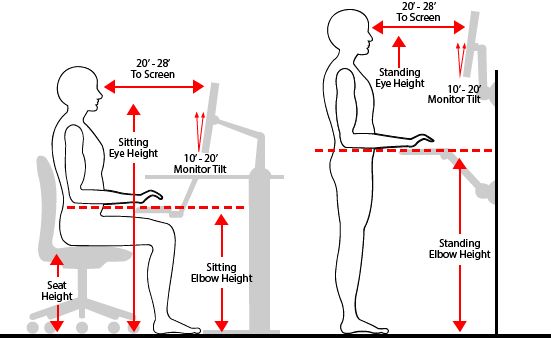The Ultimate Guide to Sitting Ball Chairs: Benefits, Tips, and Expert Advice
In the quest for better ergonomics and improved health, many have turned to sitting ball chairs as an alternative to traditional office chairs. But what exactly makes these bouncy seats so appealing? Are they truly beneficial, or just another passing trend? In this comprehensive guide, we’ll delve into the advantages and potential drawbacks of sitting ball chairs, provide tips for their effective use, and offer expert advice from WellErgon to help you make an informed decision.
The Benefits of Sitting Ball Chairs
Improved Posture
- Engages Core Muscles: Sitting on a ball requires constant micro-movements to maintain balance, which engages and strengthens your core muscles.
- Promotes Alignment: The instability encourages proper spinal alignment, reducing the tendency to slouch.
Increased Movement
- Active Sitting: Unlike conventional chairs, sitting ball chair promote active sitting, which can help reduce the risks associated with prolonged sitting.
- Encourages Micro-Movements: These small movements can enhance circulation and reduce the stiffness that comes from remaining in a static position for too long.
Enhanced Focus and Productivity
- Boosts Alertness: The need to maintain balance can keep you more alert and focused on your tasks.
- Breaks Monotony: A sitting ball chair adds variety to your workday, making it less monotonous and more engaging.
Potential Drawbacks
Initial Discomfort
- Adjustment Period: It can take time to get used to the instability of a sitting ball chair, and initial discomfort is common.
- Muscle Fatigue: Prolonged use without proper posture can lead to muscle fatigue, especially in the lower back and core.
Lack of Support
- No Backrest: Without a backrest, there is a lack of lumbar support, which might not be suitable for everyone, especially those with existing back issues.
Risk of Falls
- Stability Issues: There is a risk of falling off the ball, especially when trying to reach for something or if you lose concentration.
Tips for Effective Use
Start Slow
- Gradual Integration: Begin by using the sitting ball chair for short periods, gradually increasing the time as your core strength improves.
- Mix and Match: Alternate between a traditional chair and the sitting ball to prevent fatigue and discomfort.
Choose the Right Size
- Proper Fit: Ensure the ball is the correct size for your height. When seated, your knees should be at a 90-degree angle.
- Inflation Level: The ball should be firm but not overly inflated. You should be able to sit comfortably with your feet flat on the floor.
Maintain Good Posture
- Sit Upright: Keep your back straight and shoulders relaxed. Avoid slouching or leaning forward.
- Engage Your Core: Actively engage your core muscles to maintain balance and support your spine.
Add Stability
- Ball Base: Consider using a ball base or a ring to provide additional stability, especially when you’re new to using a sitting ball chair.
- Use a Desk: Ensure your desk and chair setup is ergonomic, with your monitor at eye level and your keyboard within easy reach.
WellErgon's Expert Advice
Wellergon's Recommendations:
- Assessment: “Before switching to a sitting ball chair, it’s essential to assess your current health and ergonomic needs. Those with existing back problems or balance issues should consult a healthcare professional.”
- Transition: “Transitioning gradually is key. Start with 15-20 minutes a few times a day and listen to your body. If you experience pain or discomfort, reduce the time or consult a specialist.”
- Complementary Exercises: “Incorporate core-strengthening exercises into your routine to support your new seating arrangement. Pilates and yoga can be particularly beneficial.”
FAQs
1. Can I use a sitting ball chair all day?
- It’s not recommended to use a sitting ball chair all day. Start with short periods and gradually increase the time as your body adjusts. Combining its use with a traditional chair is often the best approach.
2. What size sitting ball chair should I get?
- The size of the ball should match your height. Generally, a 55 cm ball is suitable for people up to 5'4", a 65 cm ball for those between 5'4" and 6'0", and a 75 cm ball for those over 6'0".
3. Is a sitting ball chair suitable for everyone?
- Sitting ball chairs may not be suitable for everyone, especially those with balance issues or existing back problems. It’s best to consult with a healthcare professional if you have any concerns.
4. How do I maintain good posture on a sitting ball chair?
- Sit upright with your feet flat on the floor, engage your core muscles, and avoid slouching or leaning forward. Adjust the ball’s inflation level to ensure comfort and stability.
5. What are the benefits of using a sitting ball chair?
- Benefits include improved posture, increased core strength, enhanced focus, and greater overall movement during the workday.
Conclusion
Sitting ball chairs offer a dynamic alternative to traditional office seating, promoting better posture, increased movement, and enhanced focus. However, they are not a one-size-fits-all solution and come with their own set of challenges. By understanding the benefits and potential drawbacks, and following expert tips, you can make an informed decision about whether a sitting ball chair is right for you.




Comments
Post a Comment